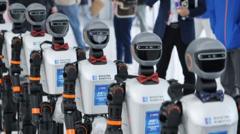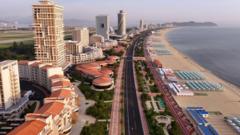At the forefront of humanoid robot development, companies like China's Unitree and Tesla are making strides, yet experts predict the Chinese market may soon dominate, raising questions about competition and technological breakthroughs.
The Race to Develop Humanoid Robots: Who Will Dominate?

The Race to Develop Humanoid Robots: Who Will Dominate?
As humanoid robot innovation escalates, industry leaders and startups alike vie for market supremacy, but challenges in AI and safety remain.
In Hanover, Germany, a spotlight shines on the Unitree G1, a humanoid robot that has struck a chord at the Hannover Messe, an influential industrial trade show. Standing at 4'3" (130cm), the G1 stands out due to its affordability and impressive fluidity of movement, leading to viral content showcasing its capabilities in dance and martial arts. Demonstrated by Pedro Zheng, Unitree's sales manager, the G1 invites interaction, signaling an intriguing future for human-robot companionship.
The burgeoning humanoid robotics market offers immense potential, present in scenarios such as reducing labor costs in countless industries or evolving into transformative domestic appliances. However, the transition from controlled factory environments to unpredictable settings like homes and restaurants remains a substantial hurdle. The inherent strength of humanoid robots introduces safety concerns, with falls posing serious risks.
"Today's robot AI has yet to achieve the necessary breakthroughs," a Unitree representative explained, noting limitations in AI’s capacity for complex tasks. Currently, the G1 can be utilized primarily by research institutions and tech firms, leveraging Unitree's open-source software. Entrepreneurs are focusing on less complex humanoid robots for industrial applications; Tesla, led by Elon Musk, is a notable player in this realm with its upcoming Optimus robot, aiming for early deployment in factories.
Sonja Thomas Andersson, a research analyst at STIQ, monitors numerous companies in the humanoid sector, estimating that around 49 are dedicated to humanoid robots alone. Expanding the category to include wheeled robots, this figure surpasses 100. Despite fierce international competition, Andersson posits that Chinese firms are poised to lead due to a robust supply chain and governmental support, with nearly 60% of investment in humanoid robotics flowing into Asian markets.
Addressing the challenge of costs, Bristol-based entrepreneur Bren Pierce has developed the KR1 robot, which will be manufactured in Asia while minimizing complexity by avoiding the full humanoid design. "Employing mass-produced components drives down the cost, and simplifies usage," he noted, aiming for accessibility for warehouse or factory employees.
While industry experts share a vision of humanoid robots entering domestic spaces, the transition is predicted to take over a decade. “My long-term goal has always been the development of a complete domestic robot," Pierce acknowledged, yet he cautioned that such ambitions remain at least 10-15 years away as the complexities of human-robot interaction continue to unfold.




















